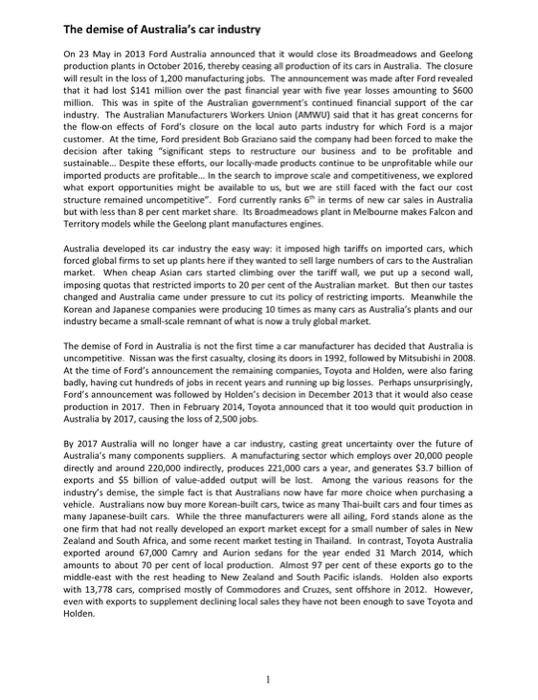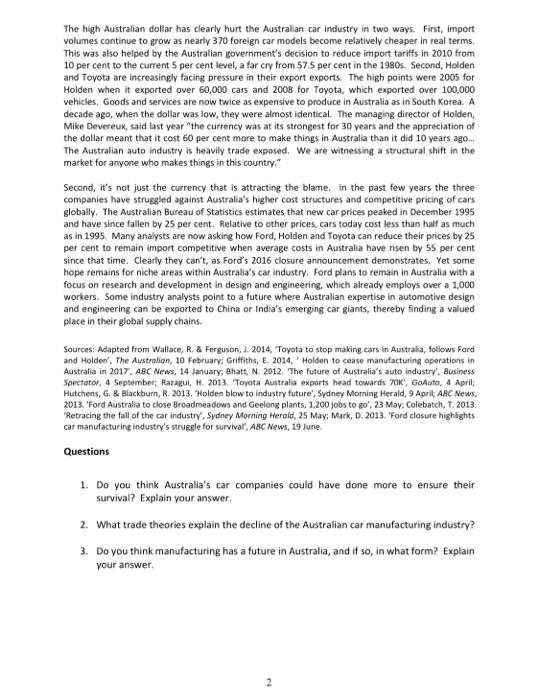Answered step by step
Verified Expert Solution
Question
1 Approved Answer
The demise of Australia's car industry On 23 May in 2013 Ford Australia announced that it would close its Broadmeadows and Geelong production plants


The demise of Australia's car industry On 23 May in 2013 Ford Australia announced that it would close its Broadmeadows and Geelong production plants in October 2016, thereby ceasing all production of its cars in Australia. The closure will result in the loss of 1,200 manufacturing jobs. The announcement was made after Ford revealed that it had lost $141 million over the past financial year with five year losses amounting to $600 million. This was in spite of the Australian government's continued financial support of the car industry. The Australian Manufacturers Workers Union (AMWU) said that it has great concerns for the flow-on effects of Ford's closure on the local auto parts industry for which Ford is a major customer. At the time, Ford president Bob Graziano said the company had been forced to make the decision after taking "significant steps to restructure our business and to be profitable and sustainable... Despite these efforts, our locally-made products continue to be unprofitable while our imported products are profitable... In the search to improve scale and competitiveness, we explored what export opportunities might be available to us, but we are still faced with the fact our cost structure remained uncompetitive". Ford currently ranks 6 in terms of new car sales in Australia but with less than 8 per cent market share. Its Broadmeadows plant in Melbourne makes Falcon and Territory models while the Geelong plant manufactures engines. Australia developed its car industry the easy way: it imposed high tariffs on imported cars, which forced global firms to set up plants here if they wanted to sell large numbers of cars to the Australian market. When cheap Asian cars started climbing over the tariff wall, we put up a second wall, imposing quotas that restricted imports to 20 per cent of the Australian market. But then our tastes changed and Australia came under pressure to cut its policy of restricting imports. Meanwhile the Korean and Japanese companies were producing 10 times as many cars as Australia's plants and our industry became a small-scale remnant of what is now a truly global market. The demise of Ford in Australia is not the first time a car manufacturer has decided that Australia is uncompetitive. Nissan was the first casualty, closing its doors in 1992, followed by Mitsubishi in 2008. At the time of Ford's announcement the remaining companies, Toyota and Holden, were also faring badly, having cut hundreds of jobs in recent years and running up big losses. Perhaps unsurprisingly, Ford's announcement was followed by Holden's decision in December 2013 that it would also cease production in 2017. Then in February 2014, Toyota announced that it too would quit production in Australia by 2017, causing the loss of 2,500 jobs. By 2017 Australia will no longer have a car industry, casting great uncertainty over the future of Australia's many components suppliers. A manufacturing sector which employs over 20,000 people directly and around 220,000 indirectly, produces 221,000 cars a year, and generates $3.7 billion of exports and $5 billion of value-added output will be lost. Among the various reasons for the industry's demise, the simple fact is that Australians now have far more choice when purchasing a vehicle. Australians now buy more Korean-built cars, twice as many Thai-built cars and four times as many Japanese-built cars. While the three manufacturers were all ailing, Ford stands alone as the one firm that had not really developed an export market except for a small number of sales in New Zealand and South Africa, and some recent market testing in Thailand. In contrast, Toyota Australia exported around 67,000 Camry and Aurion sedans for the year ended 31 March 2014, which amounts to about 70 per cent of local production. Almost 97 per cent of these exports go to the middle-east with the rest heading to New Zealand and South Pacific islands. Holden also exports with 13,778 cars, comprised mostly of Commodores and Cruzes, sent offshore in 2012. However, even with exports to supplement declining local sales they have not been enough to save Toyota and Holden. The high Australian dollar has clearly hurt the Australian car industry in two ways. First, import volumes continue to grow as nearly 370 foreign car models become relatively cheaper in real terms. This was also helped by the Australian government's decision to reduce import tariffs in 2010 from 10 per cent to the current 5 per cent level, a far cry from 57.5 per cent in the 1980s. Second, Holden and Toyota are increasingly facing pressure in their export exports. The high points were 2005 for Holden when it exported over 60,000 cars and 2008 for Toyota, which exported over 100,000 vehicles. Goods and services are now twice as expensive to produce in Australia as in South Korea. A decade ago, when the dollar was low, they were almost identical. The managing director of Holden, Mike Devereux, said last year "the currency was at its strongest for 30 years and the appreciation of the dollar meant that it cost 60 per cent more to make things in Australia than it did 10 years ago... The Australian auto industry is heavily trade exposed. We are witnessing a structural shift in the market for anyone who makes things in this country." Second, it's not just the currency that is attracting the blame. In the past few years the three companies have struggled against Australia's higher cost structures and competitive pricing of cars globally. The Australian Bureau of Statistics estimates that new car prices peaked in December 1995 and have since fallen by 25 per cent. Relative to other prices, cars today cost less than half as much as in 1995. Many analysts are now asking how Ford, Holden and Toyota can reduce their prices by 25 per cent to remain import competitive when average costs in Australia have risen by 55 per cent since that time. Clearly they can't, as Ford's 2016 closure announcement demonstrates. Yet some hope remains for niche areas within Australia's car industry. Ford plans to remain in Australia with a focus on research and development in design and engineering, which already employs over a 1,000 workers. Some industry analysts point to a future where Australian expertise in automotive design and engineering can be exported to China or India's emerging car giants, thereby finding a valued place in their global supply chains. Sources: Adapted from Wallace, R. & Ferguson, J. 2014, Toyota to stop making cars in Australia, follows Ford and Holden', The Australian, 10 February; Griffiths, E. 2014, Holden to cease manufacturing operations in Australia in 2017, ABC News, 14 January; Bhatt, N. 2012. The future of Australia's auto industry, Business Spectator, 4 September; Razagui, H. 2013. Toyota Australia exports head towards 70K', GoAuto, 4 April; Hutchens, G. & Blackburn, R. 2013. "Holden blow to industry future', Sydney Morning Herald, 9 April, ABC News, 2013. 'Ford Australia to close Broadmeadows and Geelong plants, 1,200 jobs to go', 23 May, Colebatch, T. 2013. "Retracing the fall of the car industry, Sydney Morning Herold, 25 May; Mark, D. 2013. 'Ford closure highlights car manufacturing industry's struggle for survival, ABC News, 19 June. Questions 1. Do you think Australia's car companies could have done more to ensure their survival? Explain your answer. 2. What trade theories explain the decline of the Australian car manufacturing industry? 3. Do you think manufacturing has a future in Australia, and if so, in what form? Explain your answer.
Step by Step Solution
★★★★★
3.39 Rating (155 Votes )
There are 3 Steps involved in it
Step: 1
1 Yes I do think that Australias car companies could have done more to ensure their survival They co...
Get Instant Access to Expert-Tailored Solutions
See step-by-step solutions with expert insights and AI powered tools for academic success
Step: 2

Step: 3

Ace Your Homework with AI
Get the answers you need in no time with our AI-driven, step-by-step assistance
Get Started


